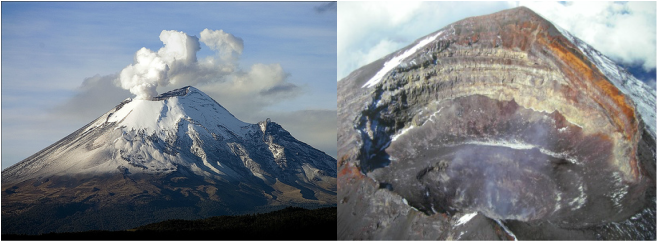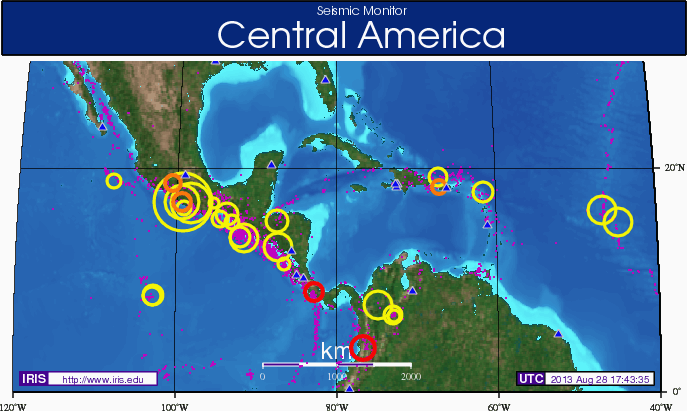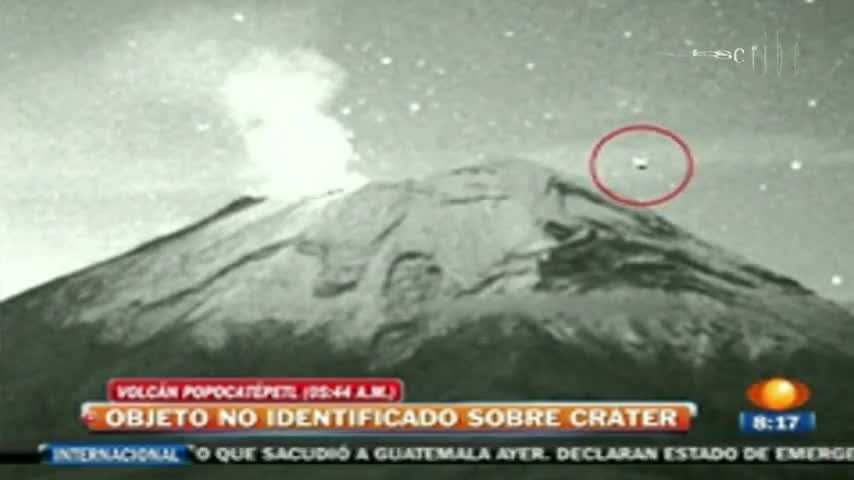Popocatepetl is a 5,426m (the second highest peak in Mexico) tall stratovolcano (or composite volcano) located in Central Mexico. Though dormant for almost 50 years, since 1994 the volcano has been moderately active at frequent intervals, fitting the description for Strombolian activity; "Mildly explosive at discrete but fairly regular intervals of seconds to minutes". It's name derives from Nahuatl, spoken widely in Mexico today and by the Aztecs, and translates to "Smoking Mountain" - suggesting that the volcano was also mildly active for long periods several hundreds of years ago.
The volcano sits on the east end of the Trans-Mexican volcanic belt, an area of volcanic activity due to the subduction of the Cocos micro-plate being subducted beneath the North American plate at a rate of roughly 1.4 cm/year.
The volcano has formed as result of laying down of layers of volcanic material such as lava (molten rock), tephra (fragmented rock pieces), pumice (low density, lightly coloured volcanic rock) and volcanic ash over the volcano's estimated 730,000 lifetime. These layers, or strata, truly make the structure a composite one and build up to create the distinctive steep-sided conical form posessed by stratovolcanoes. Lava flows are relatively viscous due to a high silica content, hence flowing short enough distances down the volcano as to progressively increase its gradient.
The volcano sits on the east end of the Trans-Mexican volcanic belt, an area of volcanic activity due to the subduction of the Cocos micro-plate being subducted beneath the North American plate at a rate of roughly 1.4 cm/year.
The volcano has formed as result of laying down of layers of volcanic material such as lava (molten rock), tephra (fragmented rock pieces), pumice (low density, lightly coloured volcanic rock) and volcanic ash over the volcano's estimated 730,000 lifetime. These layers, or strata, truly make the structure a composite one and build up to create the distinctive steep-sided conical form posessed by stratovolcanoes. Lava flows are relatively viscous due to a high silica content, hence flowing short enough distances down the volcano as to progressively increase its gradient.
Above: Interactive map (google) showing the location of Popocatépetl.
Below left: Side on view of the volcano, displaying steep sides.
Below right: View into the volcano's crater, displaying clearly it's more recent strata.
Below left: Side on view of the volcano, displaying steep sides.
Below right: View into the volcano's crater, displaying clearly it's more recent strata.
Just 70 km and within eyesight from Mexico City the volcano poses a large threat to the city's roughly 8.9 million inhabitants and constitutes a large concern for the local authorities. To quantify seismic risk, and to predict large eruptions the University of New Mexico has a seismic monitering station located nearby, indicated as a blue triangle on the image below.
Though the volcano is unlikely to affect any settlements via its lava flows, which are too viscous to flow far (though 15 km flows have been recorded of other stratovolcanoes), or indeed it's lava bombs which are only possible of projection amounting to ~800 m laterally, the ash expelled into the atmosphere from eruptions has caused some minor disruption. There are several medium-sized settlements within 20 km of the volcano, such as Atlautla (17 km W), and Ecatzingo (15 km SW), that have experienced ashfall. The farthest reaching ash clouds have reached Cuernavaca, 65 km WSW of the volcano itself.
Earthquakes are a concern too, though recently Popocatépetl's seismic activity has only reached magnitudes of around 4.5 on the richter scale.
Though the volcano is unlikely to affect any settlements via its lava flows, which are too viscous to flow far (though 15 km flows have been recorded of other stratovolcanoes), or indeed it's lava bombs which are only possible of projection amounting to ~800 m laterally, the ash expelled into the atmosphere from eruptions has caused some minor disruption. There are several medium-sized settlements within 20 km of the volcano, such as Atlautla (17 km W), and Ecatzingo (15 km SW), that have experienced ashfall. The farthest reaching ash clouds have reached Cuernavaca, 65 km WSW of the volcano itself.
Earthquakes are a concern too, though recently Popocatépetl's seismic activity has only reached magnitudes of around 4.5 on the richter scale.
Above: Map showing location, magnitude and date of seismic activity. View source for updated data and key: http://www.iris.edu/seismon/zoom/?view=eveday&lon=-100&lat=17
Below: Wegener's original publication describing continental drift; perfectally relevent.
Below: Wegener's original publication describing continental drift; perfectally relevent.
References:
Popocatépetl background:
http://www.volcanodiscovery.com/popocatepetl.html
http://en.wikipedia.org/wiki/Popocat%C3%A9petl#Eruptions
Scientific background:
http://en.wikipedia.org/wiki/Stratovolcano
http://en.wikipedia.org/wiki/Strombolian_eruption
http://www.tectonics.caltech.edu/outreach/highlights/mase/ (interesting explanation of the mexican subduction zone)
Resources:
http://ofgs.aori.u-tokyo.ac.jp/~okino/platecalc_new.html (Relative plate velocity calculator)
Activity updates:
http://www.volcanodiscovery.com/popocatepetl/news.html
http://www.volcano.si.edu/weekly_report.cfm#vn_341090
Tom Ruddell, 28/8/13



